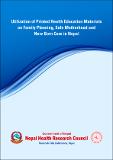Please use this identifier to cite or link to this item:
https://hdl.handle.net/20.500.14356/2705| Title: | Utilization of printed health education materials on family planning, safe motherhood and new born care in Nepal |
| Authors: | Joshi, Pramod Shrestha, Sheela |
| Citation: | Ministry of Health and Population, National Health Education, Information and Communication Centre (NHEICC). 2024. Utilization of printed health education materials on family planning, safe motherhood and new born care in Nepal |
| Issue Date: | Jun-2024 |
| Publisher: | Ministry of Health and Population, National Health Education, Information and Communication Centre (NHEICC) |
| Keywords: | Health education Materials Printed Health education Materials Family Planning Safe Motherhood New Born Nepal |
| Abstract: | Executive Summary Introduction: Health education materials in printed formats, such as pamphlets, brochures, leaflets, and flipcharts, are widely used to disseminate information on health topics like family planning, safe motherhood, and newborn care and are effective in delivering clear messages, beneficial for audiences with lower educational levels as well as culturally sensitive issues. They are cost-effective and reach a wide audience, playing a crucial role in clinical settings to reinforce verbal information from healthcare professionals and enhance patient retention. In Nepal, the National Health Education, Information, and Communication Centre (NHEICC) employs various approaches to promote health behaviors across family planning and safe motherhood and newborn care. Despite their effectiveness, addressing individual health needs remains a challenge, requiring further innovation in their design and distribution strategies. Thus, this study aimed to explore the utilization of printed health education materials in Nepal, identifying existing gaps and generating innovative ideas for developing new health education materials. Methodology: A qualitative study was carried out from Chaitra 2080 to Ashad 2081 in three local level covering three ecological regions in Nepal: Bhimeshwor Municipality in the Mountain region and Makawanpurgadi Rural Municipality in the Hilly region and Barahathawa Municipality in the Terai region. The study included in-depth interviews, key informant interviews, and focus group discussions with 34 participants comprising service providers (health workers), service receivers (Clients of health facilities), and health officials from local, district, and provincial levels. Convenience sampling was used to select the local levels and respective provinces and districts were selected for the study. Data collection tools were developed based on extensive literature reviews and study objectives. Thematic analysis was performed on translated transcriptions by identifying key themes and codes. Findings: Most participants revealed that health education materials were supplied by the NHEICC to district health offices who would then send to local levels, and local levels would provide these materials to the health facilities. However, the distribution approaches varied because the needed materials could be obtained directly through higher levels than the actual distribution channel. Similarly, the distribution of health education materials was found insufficient, with most participants noting a shortage of printed materials at district levels causing scarcity of materials at local levels, health facilities, FCHVs, and target groups. However, participants expressed available materials were effectively used during counseling sessions and mother’s group meetings, aiding in understanding and decision-making processes however most participants identified the lack of sufficient health education materials as the primary challenge. Some officials noted the decreased interest of health workers and clients in using printed materials, favoring digital tools as an alternative method. Also, participants indicated that inadequate communication, budgetary constraints, and mismanagement and misuse of materials severely hampered the availability X and utilization of health education materials. Furthermore, insufficient budget allocation and misallocation of funds exacerbated these challenges, as reported by several participants Most of the interviewed clients and mother group members in focus group discussions stated the vital role of health education materials in receiving crucial health messages, noting their significant impact on changing behavior. Most participants appreciated the content presented in simple language. However, there was a consensus on the need for regular updates of the materials to align with changed national protocols and new scientific findings. Concerns were also raised regarding the need of including local language and suggestions were made to increase font sizes to improve visibility and readability. Additionally, participants expressed the need for improved design, larger posters for clearer messaging, consolidation of information into single booklet, preference for human faces over cartoons, and integration of health messages into calendars to enhance impact. Likewise, participants emphasized diverse methods including the development of mobile applications, social media posts through the most used mobile apps (like Facebook, and TikTok), also via SMS, and caller ringtones to disseminate health education. Furthermore, the clients and health officials highlighted the continuing value of printed materials along with digital platforms to disseminate health education to a broader audience. Conclusions: The study identified major gaps in the availability, accessibility, and use of printed health education resources in Nepal. To address these difficulties, a holistic approach is required, including improved distribution channels, budget allocation, digital innovations, and stakeholder engagement. Thus, by implementing these approaches, the effectiveness of health education in Nepal can be considerably improved, resulting in better health outcomes. |
| Description: | Research Report. |
| metadata.dc.description.sponsorship: | Government of Nepal, Ministry of Health and Population, National Health Education, Information and Communication Centre (NHEICC) |
| URI: | https://hdl.handle.net/20.500.14356/2705 |
| Appears in Collections: | NHRC Research Report |
Files in This Item:
| File | Description | Size | Format | |
|---|---|---|---|---|
| Final Report on Utilization of health education (1).pdf | Download FullText Report. | 4.85 MB | Adobe PDF |  View/Open |
Items in DSpace are protected by copyright, with all rights reserved, unless otherwise indicated.
